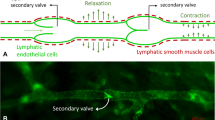Abstract
The lymphatic system returns fluid to the bloodstream from the tissues to maintain tissue fluid homeostasis. Lymph nodes distributed throughout the system filter the lymphatic fluid. The afferent and efferent lymph flow conditions of lymph nodes can be measured in experiments; however, it is difficult to measure the flow within the nodes. In this paper, we present an image-based modelling approach to investigating how the internal structure of the node affects the fluid flow pathways within the node. Selective plane illumination microscopy images of murine lymph nodes are used to identify the geometry and structure of the tissue within the node and to determine the permeability of the lymph node interstitium to lymphatic fluid. Experimental data are used to determine boundary conditions and optimise the parameters for the model. The numerical simulations conducted within the model are implemented in COMSOL Multiphysics, a commercial finite element analysis software. The parameter fitting resulted in the estimate that the average permeability for lymph node tissue is of the order of magnitude of \(10^{-11}\hbox { m}^{2}\). Our modelling shows that the flow predominantly takes a direct path between the afferent and efferent lymphatics and that fluid is both filtered and absorbed across the blood vessel boundaries. The amount that is absorbed or extravasated in the model is dependent on the efferent lymphatic lumen fluid pressure.












Similar content being viewed by others
Notes
A commercial 3D image analysis software http://www.fei.com/software/avizo3d/.
A free, open-source image processing package: http://fiji.sc/Fiji.
A commercial finite element software: http://www.comsol.com/.
A commercial software from Simpleware: https://simpleware.com/software/scanip/.
An extrinsic value that is a property of the porous media, independent of the fluid.
References
Adair TH, Guyton AC (1983) Modification of lymph by lymph nodes. II. Effect of increased lymph node venous blood pressure. Am J Physiol 245:H616–H622
Adair TH, Guyton AC (1985) Modification of lymph by lymph nodes. III. Effect of increased lymph hydrostatic pressure. Am J Physiol 249:H777–H782
Adair TH, Moffatt DS, Paulsen AW, Guyton AC (1982) Quantitiation of changes in lymph protein concentration during lymph node transit. Am J Physiol 243:H351–H359
Beltman JB, Maree AF, Lynch JN, Miller MJ, de Boer RJ (2007) Lymph node topology dictates T cell migration behavior. J Exp Med 204(4):771–780
Bogle G, Dunbar PR (2008) Simulating T-cell motility in the lymph node paracortex with a packed lattice geometry. Immunol Cell Biol 86(8):676–687
Bogle G, Dunbar PR (2010) Agent-based simulation of T-cell activation and proliferation within a lymph node. Immunol Cell Biol 88(2):172–179
Bogle G, Dunbar PR (2012) On-lattice simulation of t cell motility, chemotaxis, and trafficking in the lymph node paracortex. PLoS One 7(9):e45258
Dixon JB, Greiner ST, Gashev AA, Cote GL, Moore JE Jr, Zawieja DC (2006) Lymph flow, shear stress, and lymphocyte velocity in rat mesenteric prenodal lymphatics. Microcirculation 13:597–610
Forrester A, Sobester A, Keane A (2008) Engineering design via surrogate modelling: a practical guide. Wiley, New Jersey
Gretz JE, Norbury CC, Anderson AO, Proudfoot AE, Shaw S (2000) Lymph-borne chemokines and other low molecular weight molecules reach high endothelial venules via specialized conduits while a functional barrier limits access to the lymphocyte microenvironments in lymph node cortex. J Exp Med 192(10):1425–1440
Grigorova IL, Panteleev M, Cyster JG (2010) Lymph node cortical sinus organization and relationship to lymphocyte egress dynamics and antigen exposure. Proc Natl Acad Sci 107(47):20,447–20,452
Krige DG (1951) A statistical approach to some basic mine valuation problems on the witwatersrand. J Chem Metall Min Soc S Afr 52:119–139
Levick JR (2009) An introduction to cardiovascular physiology, 5th edn. Hodder Arnold, London
Mayer J, Swoger J, Ozga AJ, Stein JV, Sharpe J (2012) Quantitative measurements in 3-dimensional datasets of mouse lymph nodes resolve organ-wide functional dependencies. Comput Math Methods Med 128:431
Ohtani O, Ohtani Y, Carati CJ, Gannon BJ (2003) Fluid and cellular pathways of rat lymph nodes in relation to lymphatic labyrinth and Aquaporin-1 expression. Arch Histol Cytol 66:261–272
Ohtani O, Ohtani Y (2008) Structure and function of rat lymph nodes. Arch Histol Cytol 71:69–76
Renkin EM, Michel CC (eds) (1984) Handbook of physiology: section 2: the cardiovascular system, vol IV: microcirculation, part 1. American Physiological Society, Bethesda
Schindelin J, Arganda-Carreras I, Frise E, Kaynig V, Longair M, Pietzsch T, Preibisch S, Rueden C, Saalfield S, Schmid B, Tinevez J-Y, White DJ, Hartenstein V, Eliceiri K, Tomancak P, Cardona A (2012) Fiji: an open-source platform for biological-image analysis. Nat Methods 9:676–682
Swartz MA, Fleury ME (2007) Intersititial flow and its effect in soft tissues. Annu Rev Biomed Eng 9:229–256
Tomei AA, Siegert S, Britschgi MR, Luther SA, Swartz MA (2009) Fluid flow regulates stromal cell organization and CCL21 expression in a tissue-engineered lymph node microenvironment. J Immunol 183(7):4273–4283
Acknowledgments
We gratefully acknowledge the assistance of Jürgen Mayer [EMBL/CRG Systems Biology Research Unit, Center for Genomic Regulation (CRG) and UPF, Dr. Aiguader 88, 08003, Barcelona, Spain] who provided the lymph node images. L.J.C. was funded partially by a Ph.D. studentship awarded by the Institute of Life Sciences and supplemented with a studentship awarded by the Faculty of Engineering and the Environment at the University of Southampton. The authors acknowledge the use of the IRIDIS High Performance Computing Facility and the \(\upmu \)-VIS Centre for computed tomography, at the University of Southampton in the completion of this work. Data supporting this study are available from the University of Southampton repository at http://dx.doi.org/10.5258/SOTON/384621.
Author information
Authors and Affiliations
Corresponding author
Rights and permissions
About this article
Cite this article
Cooper, L.J., Heppell, J.P., Clough, G.F. et al. An Image-Based Model of Fluid Flow Through Lymph Nodes. Bull Math Biol 78, 52–71 (2016). https://doi.org/10.1007/s11538-015-0128-y
Received:
Accepted:
Published:
Issue Date:
DOI: https://doi.org/10.1007/s11538-015-0128-y




